Social Determinants of Health in Aboriginal Communities Report
VerifiedAdded on 2023/06/09
|9
|1877
|151
Report
AI Summary
This report, focusing on the health of Aboriginal and Torres Strait Islander communities in Australia, examines the influence of social determinants of health (SDH) on their well-being. It analyzes key SDH including education and literacy, social environment, employment and working conditions, physical environment (water and sanitation), and access to health services. The report highlights inequalities in these areas, such as lower education attainment, overcrowded housing, higher unemployment rates, inadequate sanitation, and limited access to healthcare, which contribute to poorer health outcomes, including lower life expectancy and higher rates of chronic diseases and infectious diseases. The report concludes that addressing these SDH is crucial for improving the health, well-being, and quality of life for Aboriginal and Torres Strait Islander populations. The report uses the SDH Assessment Circle to discuss the health of a chosen community, following the guidelines of the assignment brief.
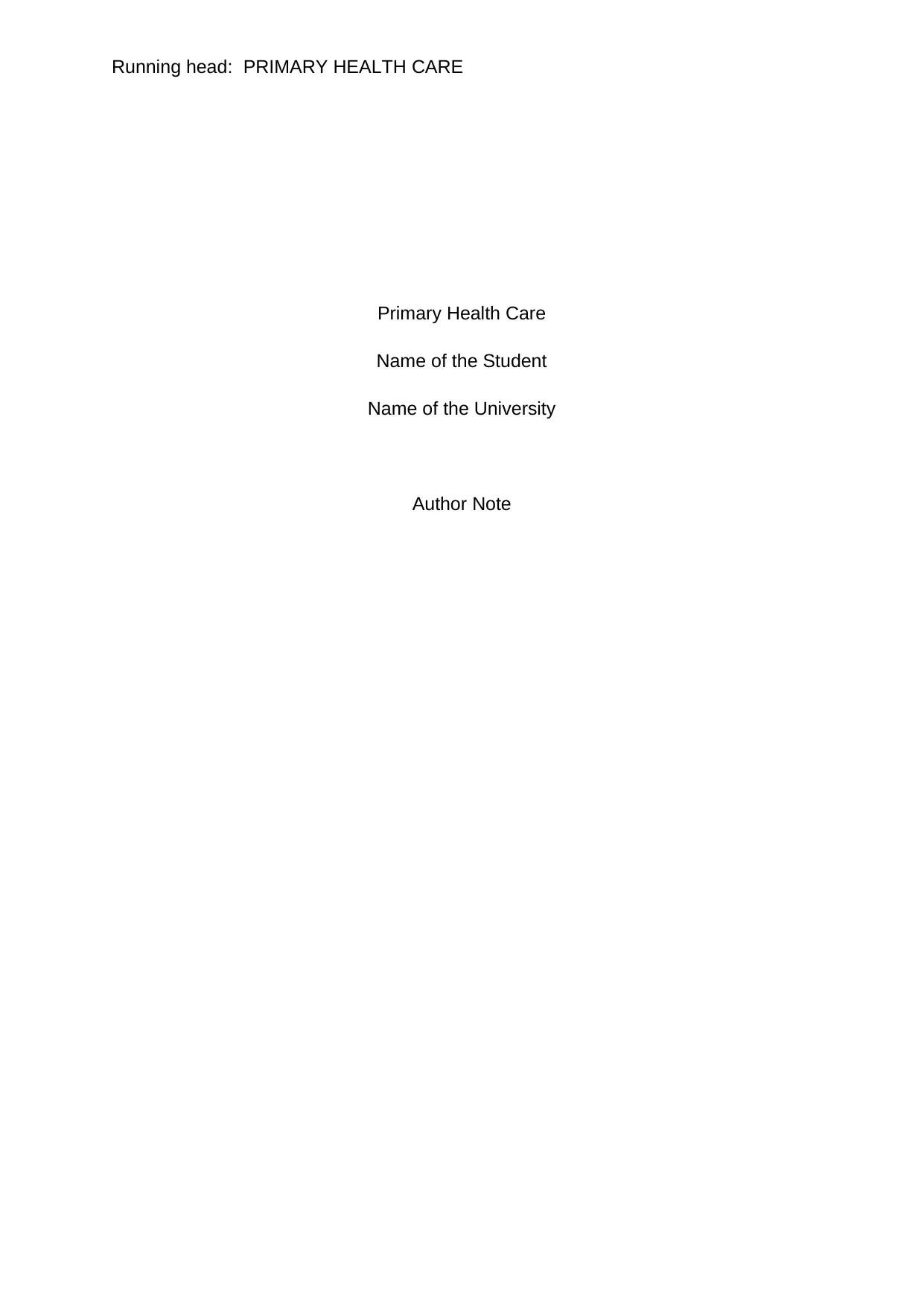
Running head: PRIMARY HEALTH CARE
Primary Health Care
Name of the Student
Name of the University
Author Note
Primary Health Care
Name of the Student
Name of the University
Author Note
Paraphrase This Document
Need a fresh take? Get an instant paraphrase of this document with our AI Paraphraser
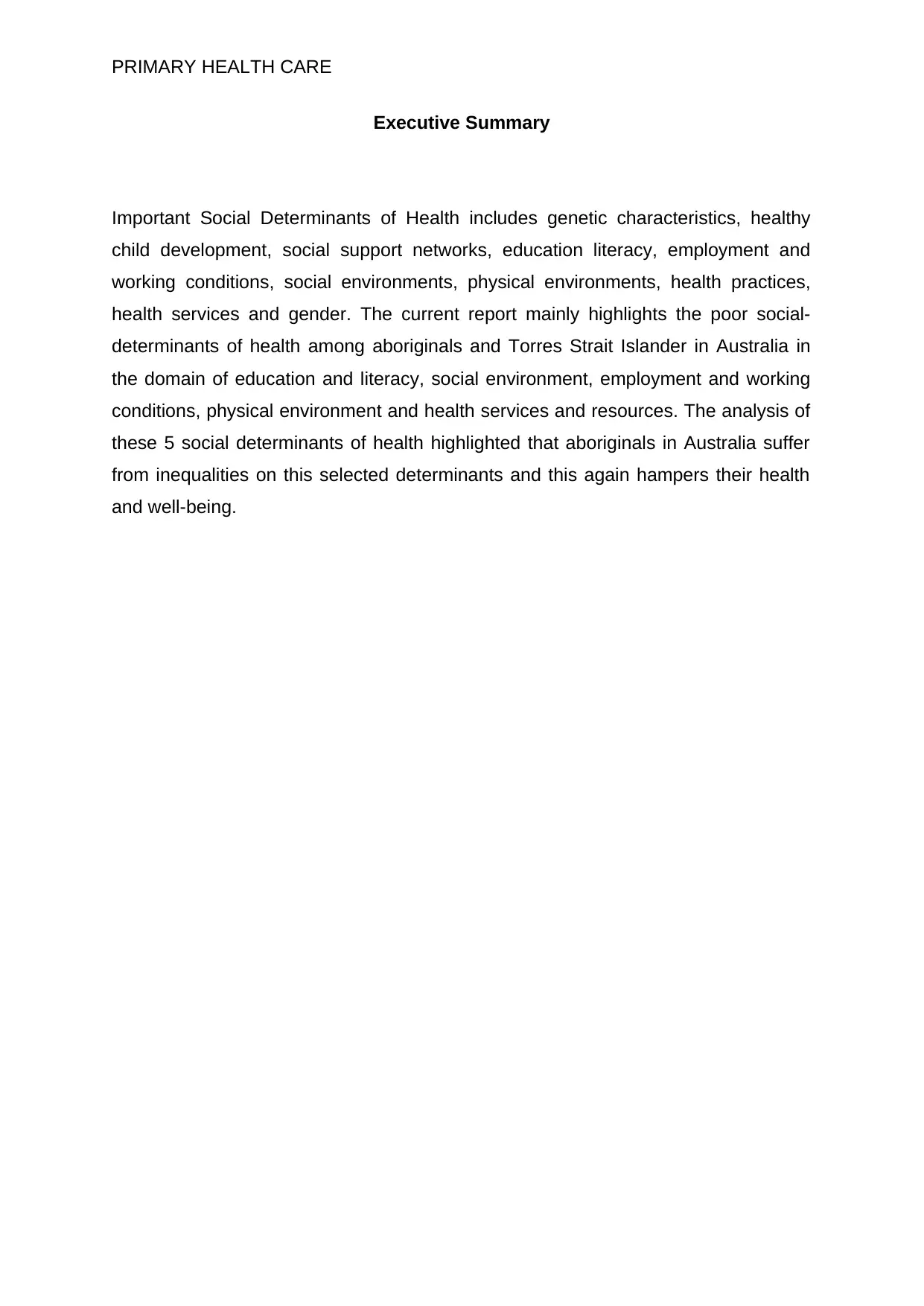
PRIMARY HEALTH CARE
Executive Summary
Important Social Determinants of Health includes genetic characteristics, healthy
child development, social support networks, education literacy, employment and
working conditions, social environments, physical environments, health practices,
health services and gender. The current report mainly highlights the poor social-
determinants of health among aboriginals and Torres Strait Islander in Australia in
the domain of education and literacy, social environment, employment and working
conditions, physical environment and health services and resources. The analysis of
these 5 social determinants of health highlighted that aboriginals in Australia suffer
from inequalities on this selected determinants and this again hampers their health
and well-being.
Executive Summary
Important Social Determinants of Health includes genetic characteristics, healthy
child development, social support networks, education literacy, employment and
working conditions, social environments, physical environments, health practices,
health services and gender. The current report mainly highlights the poor social-
determinants of health among aboriginals and Torres Strait Islander in Australia in
the domain of education and literacy, social environment, employment and working
conditions, physical environment and health services and resources. The analysis of
these 5 social determinants of health highlighted that aboriginals in Australia suffer
from inequalities on this selected determinants and this again hampers their health
and well-being.
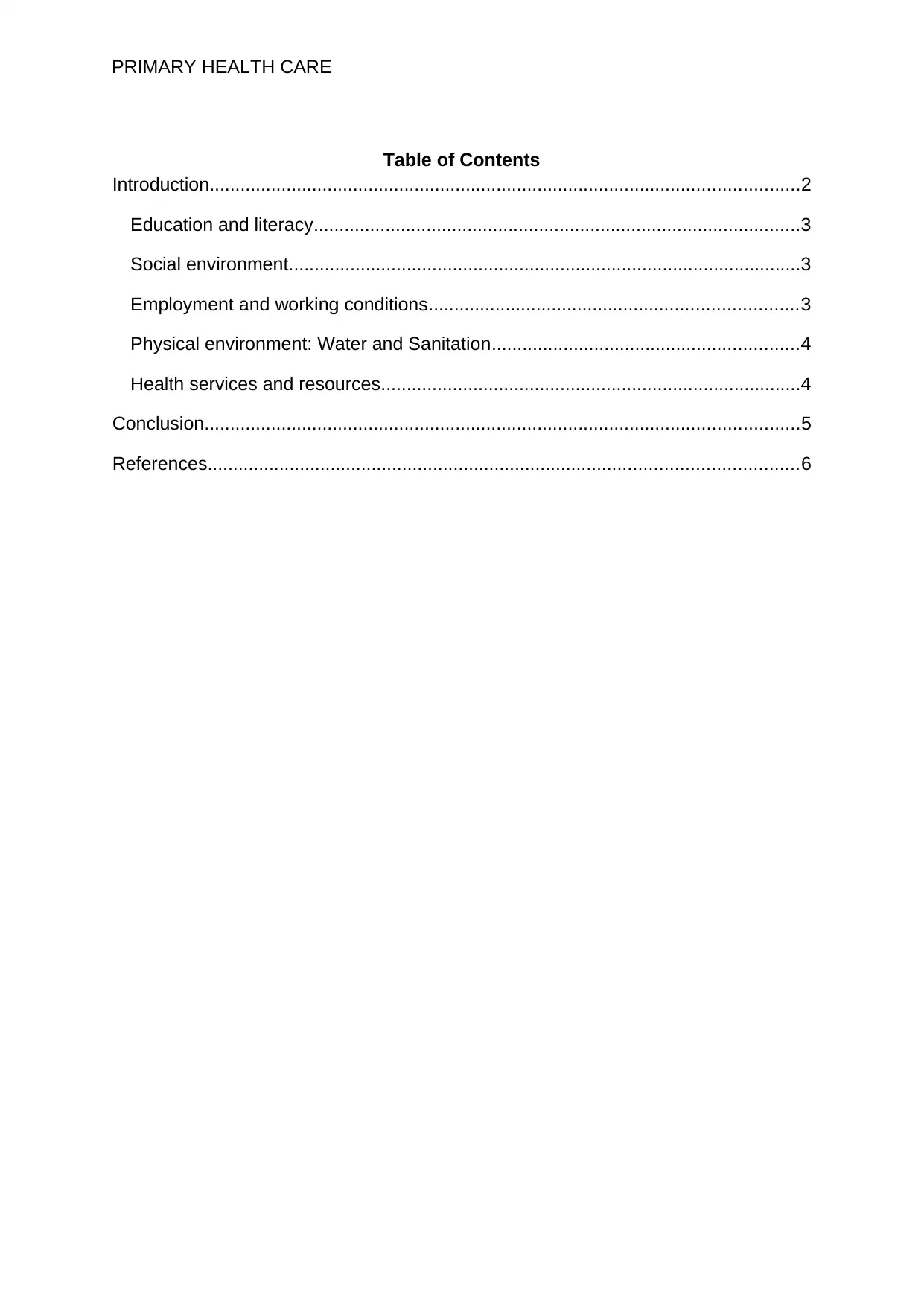
PRIMARY HEALTH CARE
Table of Contents
Introduction...................................................................................................................2
Education and literacy...............................................................................................3
Social environment....................................................................................................3
Employment and working conditions........................................................................3
Physical environment: Water and Sanitation............................................................4
Health services and resources..................................................................................4
Conclusion....................................................................................................................5
References...................................................................................................................6
Table of Contents
Introduction...................................................................................................................2
Education and literacy...............................................................................................3
Social environment....................................................................................................3
Employment and working conditions........................................................................3
Physical environment: Water and Sanitation............................................................4
Health services and resources..................................................................................4
Conclusion....................................................................................................................5
References...................................................................................................................6
⊘ This is a preview!⊘
Do you want full access?
Subscribe today to unlock all pages.

Trusted by 1+ million students worldwide
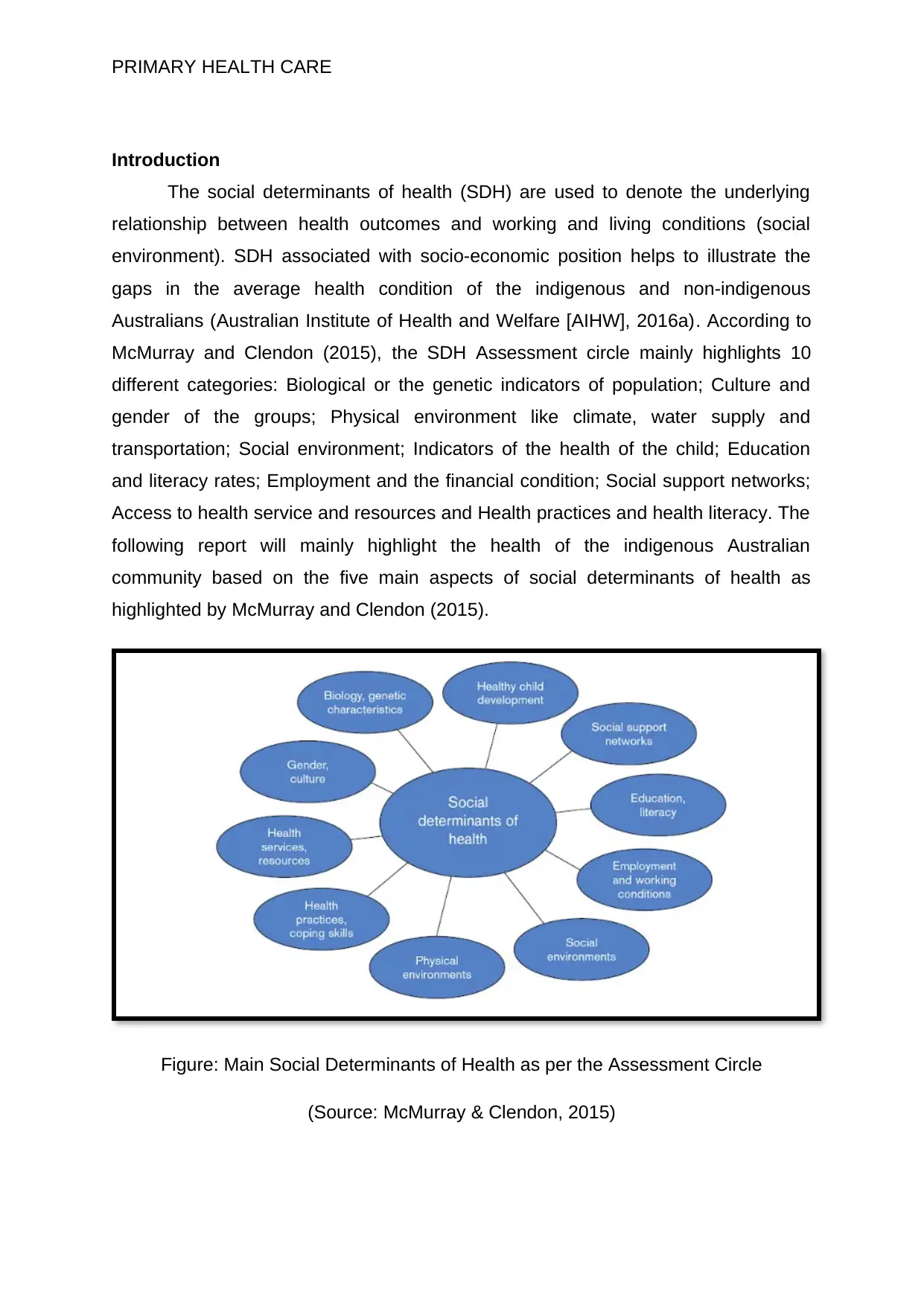
PRIMARY HEALTH CARE
Introduction
The social determinants of health (SDH) are used to denote the underlying
relationship between health outcomes and working and living conditions (social
environment). SDH associated with socio-economic position helps to illustrate the
gaps in the average health condition of the indigenous and non-indigenous
Australians (Australian Institute of Health and Welfare [AIHW], 2016a). According to
McMurray and Clendon (2015), the SDH Assessment circle mainly highlights 10
different categories: Biological or the genetic indicators of population; Culture and
gender of the groups; Physical environment like climate, water supply and
transportation; Social environment; Indicators of the health of the child; Education
and literacy rates; Employment and the financial condition; Social support networks;
Access to health service and resources and Health practices and health literacy. The
following report will mainly highlight the health of the indigenous Australian
community based on the five main aspects of social determinants of health as
highlighted by McMurray and Clendon (2015).
Figure: Main Social Determinants of Health as per the Assessment Circle
(Source: McMurray & Clendon, 2015)
Introduction
The social determinants of health (SDH) are used to denote the underlying
relationship between health outcomes and working and living conditions (social
environment). SDH associated with socio-economic position helps to illustrate the
gaps in the average health condition of the indigenous and non-indigenous
Australians (Australian Institute of Health and Welfare [AIHW], 2016a). According to
McMurray and Clendon (2015), the SDH Assessment circle mainly highlights 10
different categories: Biological or the genetic indicators of population; Culture and
gender of the groups; Physical environment like climate, water supply and
transportation; Social environment; Indicators of the health of the child; Education
and literacy rates; Employment and the financial condition; Social support networks;
Access to health service and resources and Health practices and health literacy. The
following report will mainly highlight the health of the indigenous Australian
community based on the five main aspects of social determinants of health as
highlighted by McMurray and Clendon (2015).
Figure: Main Social Determinants of Health as per the Assessment Circle
(Source: McMurray & Clendon, 2015)
Paraphrase This Document
Need a fresh take? Get an instant paraphrase of this document with our AI Paraphraser
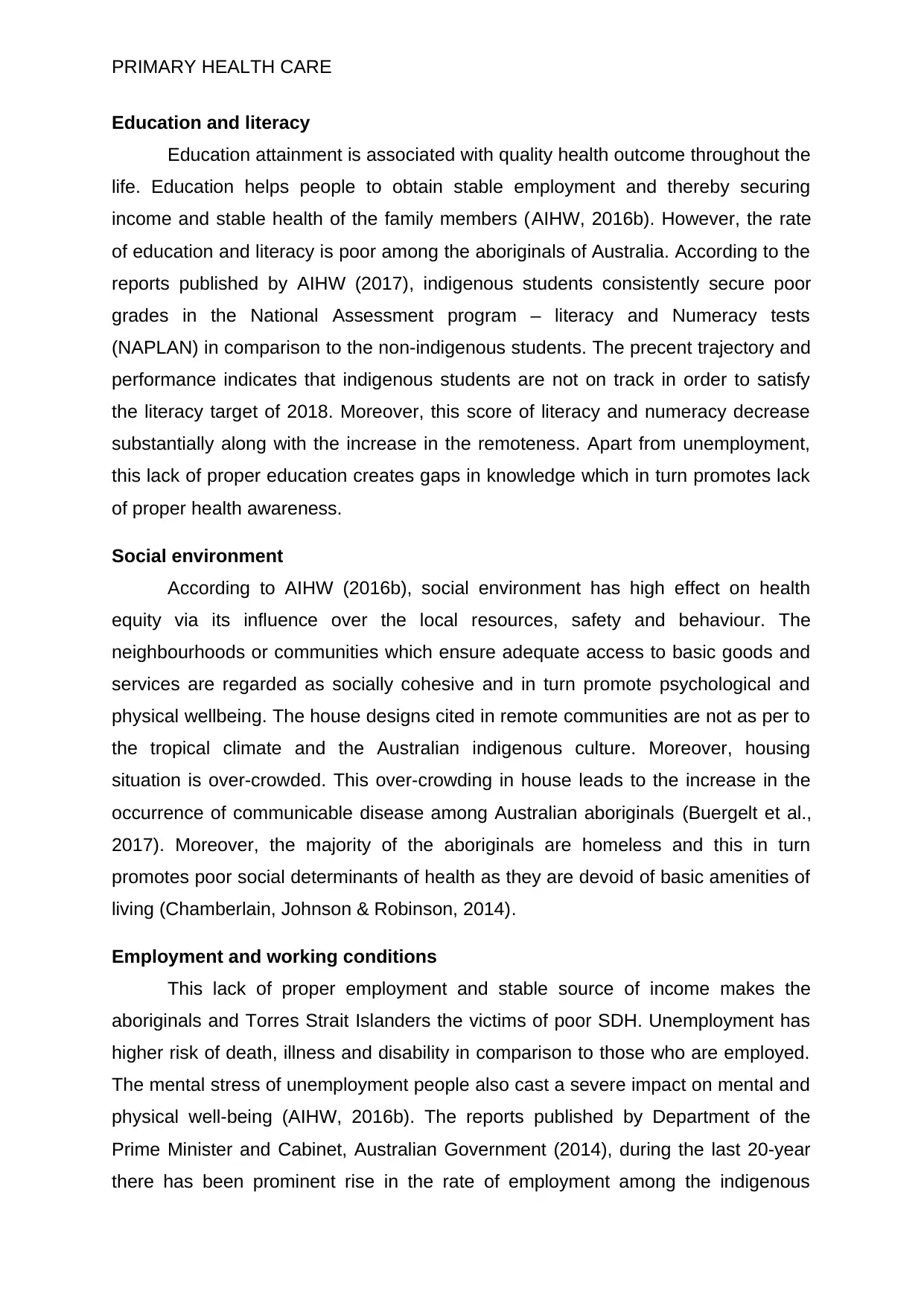
PRIMARY HEALTH CARE
Education and literacy
Education attainment is associated with quality health outcome throughout the
life. Education helps people to obtain stable employment and thereby securing
income and stable health of the family members (AIHW, 2016b). However, the rate
of education and literacy is poor among the aboriginals of Australia. According to the
reports published by AIHW (2017), indigenous students consistently secure poor
grades in the National Assessment program – literacy and Numeracy tests
(NAPLAN) in comparison to the non-indigenous students. The precent trajectory and
performance indicates that indigenous students are not on track in order to satisfy
the literacy target of 2018. Moreover, this score of literacy and numeracy decrease
substantially along with the increase in the remoteness. Apart from unemployment,
this lack of proper education creates gaps in knowledge which in turn promotes lack
of proper health awareness.
Social environment
According to AIHW (2016b), social environment has high effect on health
equity via its influence over the local resources, safety and behaviour. The
neighbourhoods or communities which ensure adequate access to basic goods and
services are regarded as socially cohesive and in turn promote psychological and
physical wellbeing. The house designs cited in remote communities are not as per to
the tropical climate and the Australian indigenous culture. Moreover, housing
situation is over-crowded. This over-crowding in house leads to the increase in the
occurrence of communicable disease among Australian aboriginals (Buergelt et al.,
2017). Moreover, the majority of the aboriginals are homeless and this in turn
promotes poor social determinants of health as they are devoid of basic amenities of
living (Chamberlain, Johnson & Robinson, 2014).
Employment and working conditions
This lack of proper employment and stable source of income makes the
aboriginals and Torres Strait Islanders the victims of poor SDH. Unemployment has
higher risk of death, illness and disability in comparison to those who are employed.
The mental stress of unemployment people also cast a severe impact on mental and
physical well-being (AIHW, 2016b). The reports published by Department of the
Prime Minister and Cabinet, Australian Government (2014), during the last 20-year
there has been prominent rise in the rate of employment among the indigenous
Education and literacy
Education attainment is associated with quality health outcome throughout the
life. Education helps people to obtain stable employment and thereby securing
income and stable health of the family members (AIHW, 2016b). However, the rate
of education and literacy is poor among the aboriginals of Australia. According to the
reports published by AIHW (2017), indigenous students consistently secure poor
grades in the National Assessment program – literacy and Numeracy tests
(NAPLAN) in comparison to the non-indigenous students. The precent trajectory and
performance indicates that indigenous students are not on track in order to satisfy
the literacy target of 2018. Moreover, this score of literacy and numeracy decrease
substantially along with the increase in the remoteness. Apart from unemployment,
this lack of proper education creates gaps in knowledge which in turn promotes lack
of proper health awareness.
Social environment
According to AIHW (2016b), social environment has high effect on health
equity via its influence over the local resources, safety and behaviour. The
neighbourhoods or communities which ensure adequate access to basic goods and
services are regarded as socially cohesive and in turn promote psychological and
physical wellbeing. The house designs cited in remote communities are not as per to
the tropical climate and the Australian indigenous culture. Moreover, housing
situation is over-crowded. This over-crowding in house leads to the increase in the
occurrence of communicable disease among Australian aboriginals (Buergelt et al.,
2017). Moreover, the majority of the aboriginals are homeless and this in turn
promotes poor social determinants of health as they are devoid of basic amenities of
living (Chamberlain, Johnson & Robinson, 2014).
Employment and working conditions
This lack of proper employment and stable source of income makes the
aboriginals and Torres Strait Islanders the victims of poor SDH. Unemployment has
higher risk of death, illness and disability in comparison to those who are employed.
The mental stress of unemployment people also cast a severe impact on mental and
physical well-being (AIHW, 2016b). The reports published by Department of the
Prime Minister and Cabinet, Australian Government (2014), during the last 20-year
there has been prominent rise in the rate of employment among the indigenous
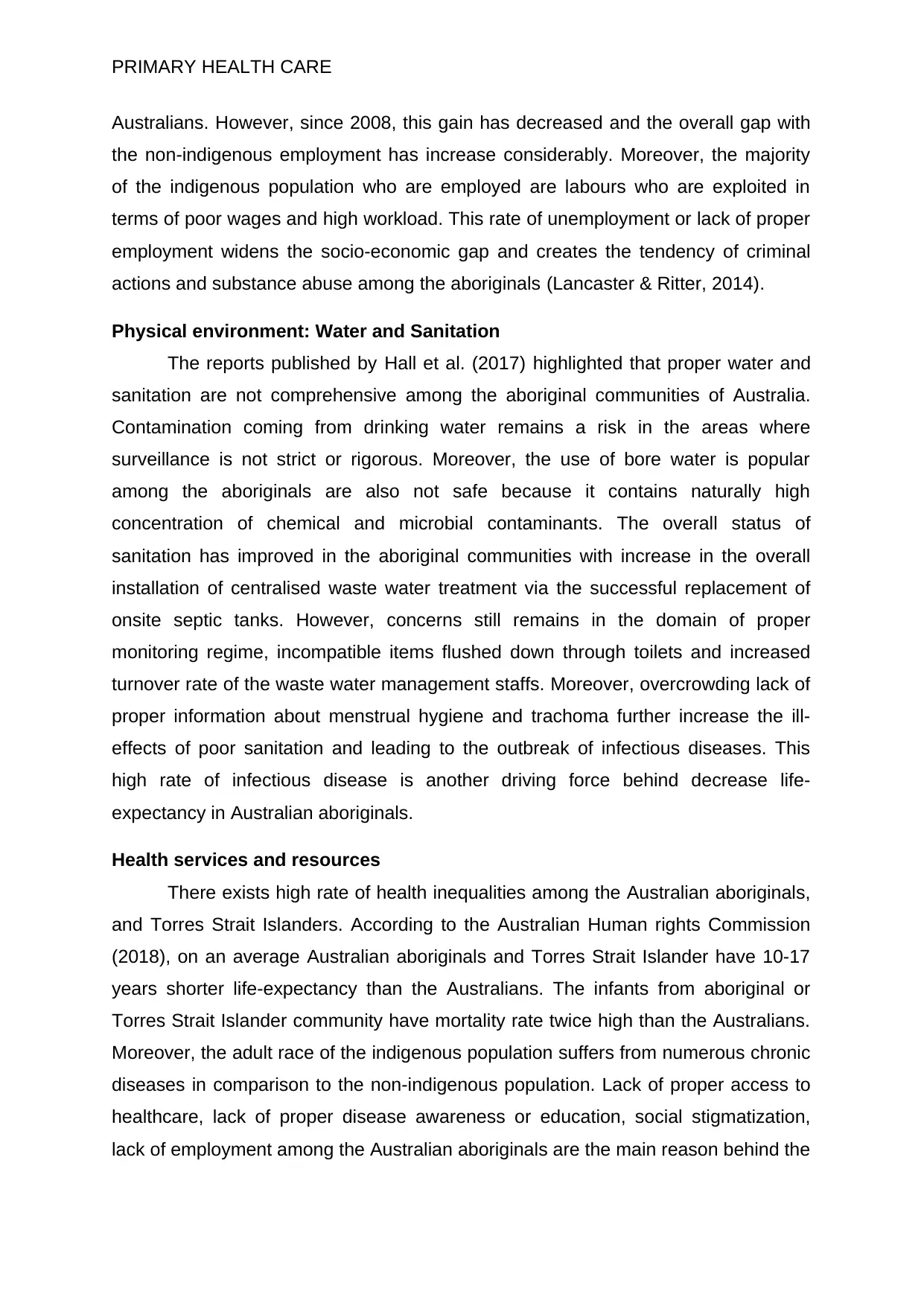
PRIMARY HEALTH CARE
Australians. However, since 2008, this gain has decreased and the overall gap with
the non-indigenous employment has increase considerably. Moreover, the majority
of the indigenous population who are employed are labours who are exploited in
terms of poor wages and high workload. This rate of unemployment or lack of proper
employment widens the socio-economic gap and creates the tendency of criminal
actions and substance abuse among the aboriginals (Lancaster & Ritter, 2014).
Physical environment: Water and Sanitation
The reports published by Hall et al. (2017) highlighted that proper water and
sanitation are not comprehensive among the aboriginal communities of Australia.
Contamination coming from drinking water remains a risk in the areas where
surveillance is not strict or rigorous. Moreover, the use of bore water is popular
among the aboriginals are also not safe because it contains naturally high
concentration of chemical and microbial contaminants. The overall status of
sanitation has improved in the aboriginal communities with increase in the overall
installation of centralised waste water treatment via the successful replacement of
onsite septic tanks. However, concerns still remains in the domain of proper
monitoring regime, incompatible items flushed down through toilets and increased
turnover rate of the waste water management staffs. Moreover, overcrowding lack of
proper information about menstrual hygiene and trachoma further increase the ill-
effects of poor sanitation and leading to the outbreak of infectious diseases. This
high rate of infectious disease is another driving force behind decrease life-
expectancy in Australian aboriginals.
Health services and resources
There exists high rate of health inequalities among the Australian aboriginals,
and Torres Strait Islanders. According to the Australian Human rights Commission
(2018), on an average Australian aboriginals and Torres Strait Islander have 10-17
years shorter life-expectancy than the Australians. The infants from aboriginal or
Torres Strait Islander community have mortality rate twice high than the Australians.
Moreover, the adult race of the indigenous population suffers from numerous chronic
diseases in comparison to the non-indigenous population. Lack of proper access to
healthcare, lack of proper disease awareness or education, social stigmatization,
lack of employment among the Australian aboriginals are the main reason behind the
Australians. However, since 2008, this gain has decreased and the overall gap with
the non-indigenous employment has increase considerably. Moreover, the majority
of the indigenous population who are employed are labours who are exploited in
terms of poor wages and high workload. This rate of unemployment or lack of proper
employment widens the socio-economic gap and creates the tendency of criminal
actions and substance abuse among the aboriginals (Lancaster & Ritter, 2014).
Physical environment: Water and Sanitation
The reports published by Hall et al. (2017) highlighted that proper water and
sanitation are not comprehensive among the aboriginal communities of Australia.
Contamination coming from drinking water remains a risk in the areas where
surveillance is not strict or rigorous. Moreover, the use of bore water is popular
among the aboriginals are also not safe because it contains naturally high
concentration of chemical and microbial contaminants. The overall status of
sanitation has improved in the aboriginal communities with increase in the overall
installation of centralised waste water treatment via the successful replacement of
onsite septic tanks. However, concerns still remains in the domain of proper
monitoring regime, incompatible items flushed down through toilets and increased
turnover rate of the waste water management staffs. Moreover, overcrowding lack of
proper information about menstrual hygiene and trachoma further increase the ill-
effects of poor sanitation and leading to the outbreak of infectious diseases. This
high rate of infectious disease is another driving force behind decrease life-
expectancy in Australian aboriginals.
Health services and resources
There exists high rate of health inequalities among the Australian aboriginals,
and Torres Strait Islanders. According to the Australian Human rights Commission
(2018), on an average Australian aboriginals and Torres Strait Islander have 10-17
years shorter life-expectancy than the Australians. The infants from aboriginal or
Torres Strait Islander community have mortality rate twice high than the Australians.
Moreover, the adult race of the indigenous population suffers from numerous chronic
diseases in comparison to the non-indigenous population. Lack of proper access to
healthcare, lack of proper disease awareness or education, social stigmatization,
lack of employment among the Australian aboriginals are the main reason behind the
⊘ This is a preview!⊘
Do you want full access?
Subscribe today to unlock all pages.

Trusted by 1+ million students worldwide
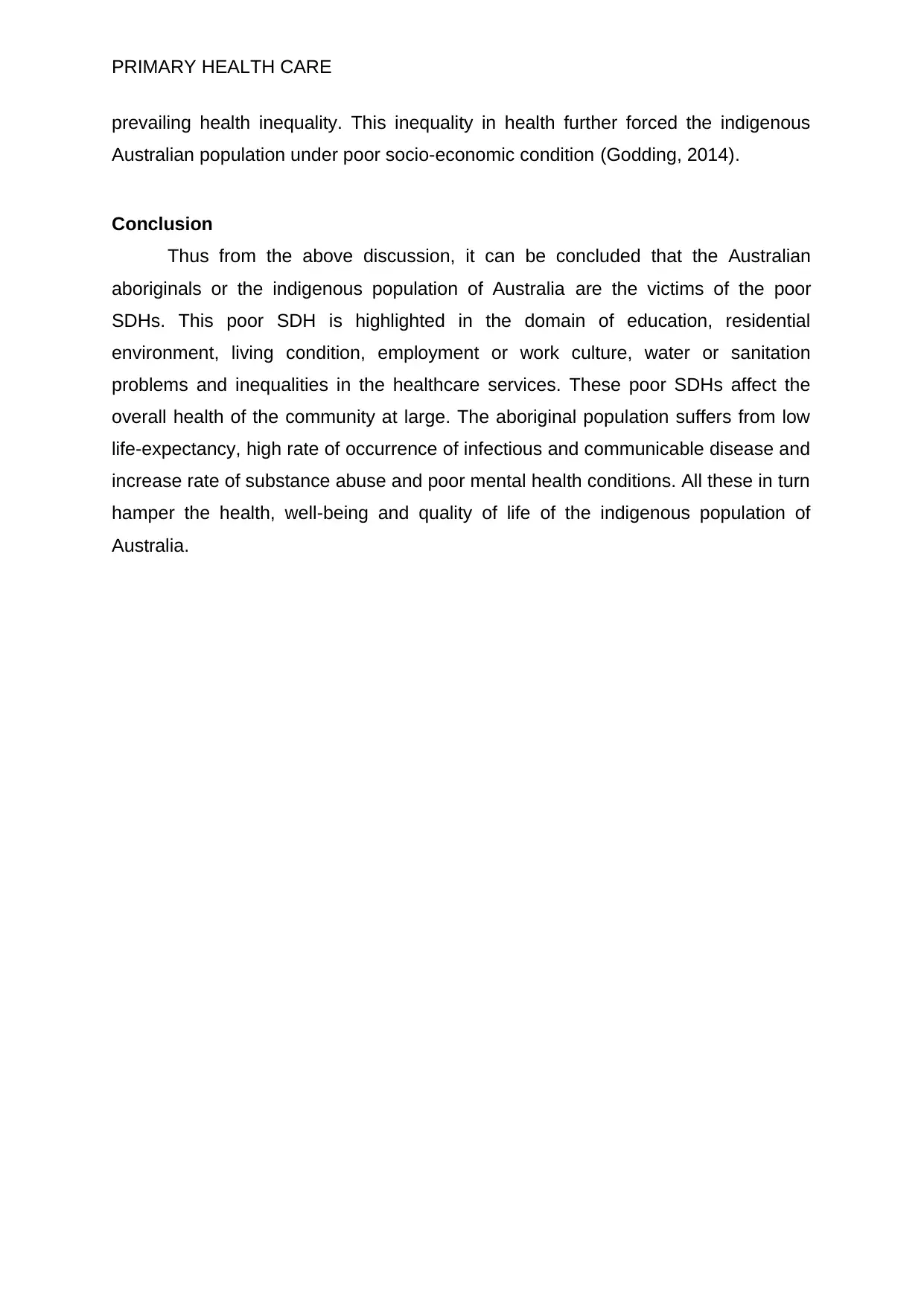
PRIMARY HEALTH CARE
prevailing health inequality. This inequality in health further forced the indigenous
Australian population under poor socio-economic condition (Godding, 2014).
Conclusion
Thus from the above discussion, it can be concluded that the Australian
aboriginals or the indigenous population of Australia are the victims of the poor
SDHs. This poor SDH is highlighted in the domain of education, residential
environment, living condition, employment or work culture, water or sanitation
problems and inequalities in the healthcare services. These poor SDHs affect the
overall health of the community at large. The aboriginal population suffers from low
life-expectancy, high rate of occurrence of infectious and communicable disease and
increase rate of substance abuse and poor mental health conditions. All these in turn
hamper the health, well-being and quality of life of the indigenous population of
Australia.
prevailing health inequality. This inequality in health further forced the indigenous
Australian population under poor socio-economic condition (Godding, 2014).
Conclusion
Thus from the above discussion, it can be concluded that the Australian
aboriginals or the indigenous population of Australia are the victims of the poor
SDHs. This poor SDH is highlighted in the domain of education, residential
environment, living condition, employment or work culture, water or sanitation
problems and inequalities in the healthcare services. These poor SDHs affect the
overall health of the community at large. The aboriginal population suffers from low
life-expectancy, high rate of occurrence of infectious and communicable disease and
increase rate of substance abuse and poor mental health conditions. All these in turn
hamper the health, well-being and quality of life of the indigenous population of
Australia.
Paraphrase This Document
Need a fresh take? Get an instant paraphrase of this document with our AI Paraphraser
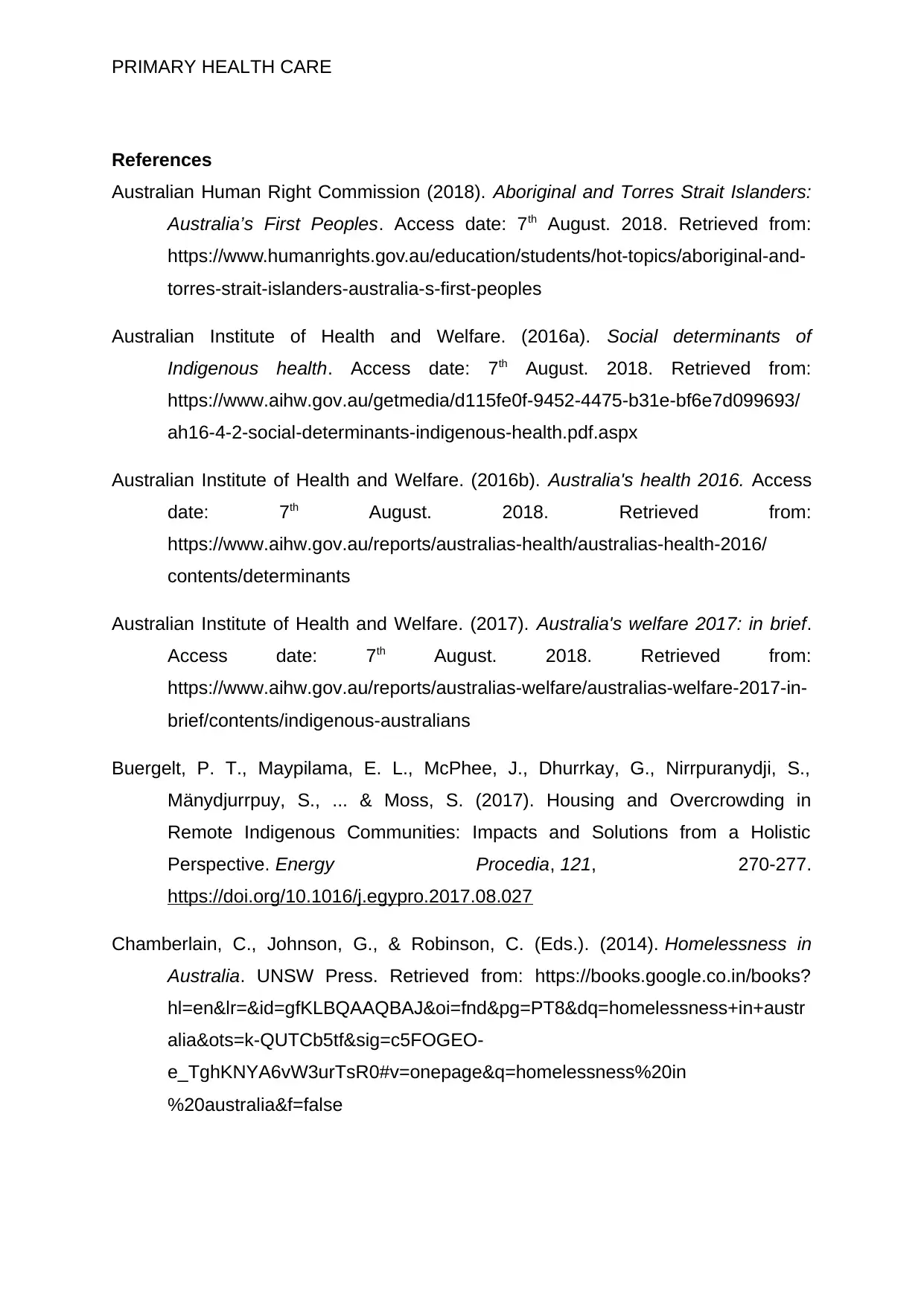
PRIMARY HEALTH CARE
References
Australian Human Right Commission (2018). Aboriginal and Torres Strait Islanders:
Australia’s First Peoples. Access date: 7th August. 2018. Retrieved from:
https://www.humanrights.gov.au/education/students/hot-topics/aboriginal-and-
torres-strait-islanders-australia-s-first-peoples
Australian Institute of Health and Welfare. (2016a). Social determinants of
Indigenous health. Access date: 7th August. 2018. Retrieved from:
https://www.aihw.gov.au/getmedia/d115fe0f-9452-4475-b31e-bf6e7d099693/
ah16-4-2-social-determinants-indigenous-health.pdf.aspx
Australian Institute of Health and Welfare. (2016b). Australia's health 2016. Access
date: 7th August. 2018. Retrieved from:
https://www.aihw.gov.au/reports/australias-health/australias-health-2016/
contents/determinants
Australian Institute of Health and Welfare. (2017). Australia's welfare 2017: in brief.
Access date: 7th August. 2018. Retrieved from:
https://www.aihw.gov.au/reports/australias-welfare/australias-welfare-2017-in-
brief/contents/indigenous-australians
Buergelt, P. T., Maypilama, E. L., McPhee, J., Dhurrkay, G., Nirrpuranydji, S.,
Mänydjurrpuy, S., ... & Moss, S. (2017). Housing and Overcrowding in
Remote Indigenous Communities: Impacts and Solutions from a Holistic
Perspective. Energy Procedia, 121, 270-277.
https://doi.org/10.1016/j.egypro.2017.08.027
Chamberlain, C., Johnson, G., & Robinson, C. (Eds.). (2014). Homelessness in
Australia. UNSW Press. Retrieved from: https://books.google.co.in/books?
hl=en&lr=&id=gfKLBQAAQBAJ&oi=fnd&pg=PT8&dq=homelessness+in+austr
alia&ots=k-QUTCb5tf&sig=c5FOGEO-
e_TghKNYA6vW3urTsR0#v=onepage&q=homelessness%20in
%20australia&f=false
References
Australian Human Right Commission (2018). Aboriginal and Torres Strait Islanders:
Australia’s First Peoples. Access date: 7th August. 2018. Retrieved from:
https://www.humanrights.gov.au/education/students/hot-topics/aboriginal-and-
torres-strait-islanders-australia-s-first-peoples
Australian Institute of Health and Welfare. (2016a). Social determinants of
Indigenous health. Access date: 7th August. 2018. Retrieved from:
https://www.aihw.gov.au/getmedia/d115fe0f-9452-4475-b31e-bf6e7d099693/
ah16-4-2-social-determinants-indigenous-health.pdf.aspx
Australian Institute of Health and Welfare. (2016b). Australia's health 2016. Access
date: 7th August. 2018. Retrieved from:
https://www.aihw.gov.au/reports/australias-health/australias-health-2016/
contents/determinants
Australian Institute of Health and Welfare. (2017). Australia's welfare 2017: in brief.
Access date: 7th August. 2018. Retrieved from:
https://www.aihw.gov.au/reports/australias-welfare/australias-welfare-2017-in-
brief/contents/indigenous-australians
Buergelt, P. T., Maypilama, E. L., McPhee, J., Dhurrkay, G., Nirrpuranydji, S.,
Mänydjurrpuy, S., ... & Moss, S. (2017). Housing and Overcrowding in
Remote Indigenous Communities: Impacts and Solutions from a Holistic
Perspective. Energy Procedia, 121, 270-277.
https://doi.org/10.1016/j.egypro.2017.08.027
Chamberlain, C., Johnson, G., & Robinson, C. (Eds.). (2014). Homelessness in
Australia. UNSW Press. Retrieved from: https://books.google.co.in/books?
hl=en&lr=&id=gfKLBQAAQBAJ&oi=fnd&pg=PT8&dq=homelessness+in+austr
alia&ots=k-QUTCb5tf&sig=c5FOGEO-
e_TghKNYA6vW3urTsR0#v=onepage&q=homelessness%20in
%20australia&f=false
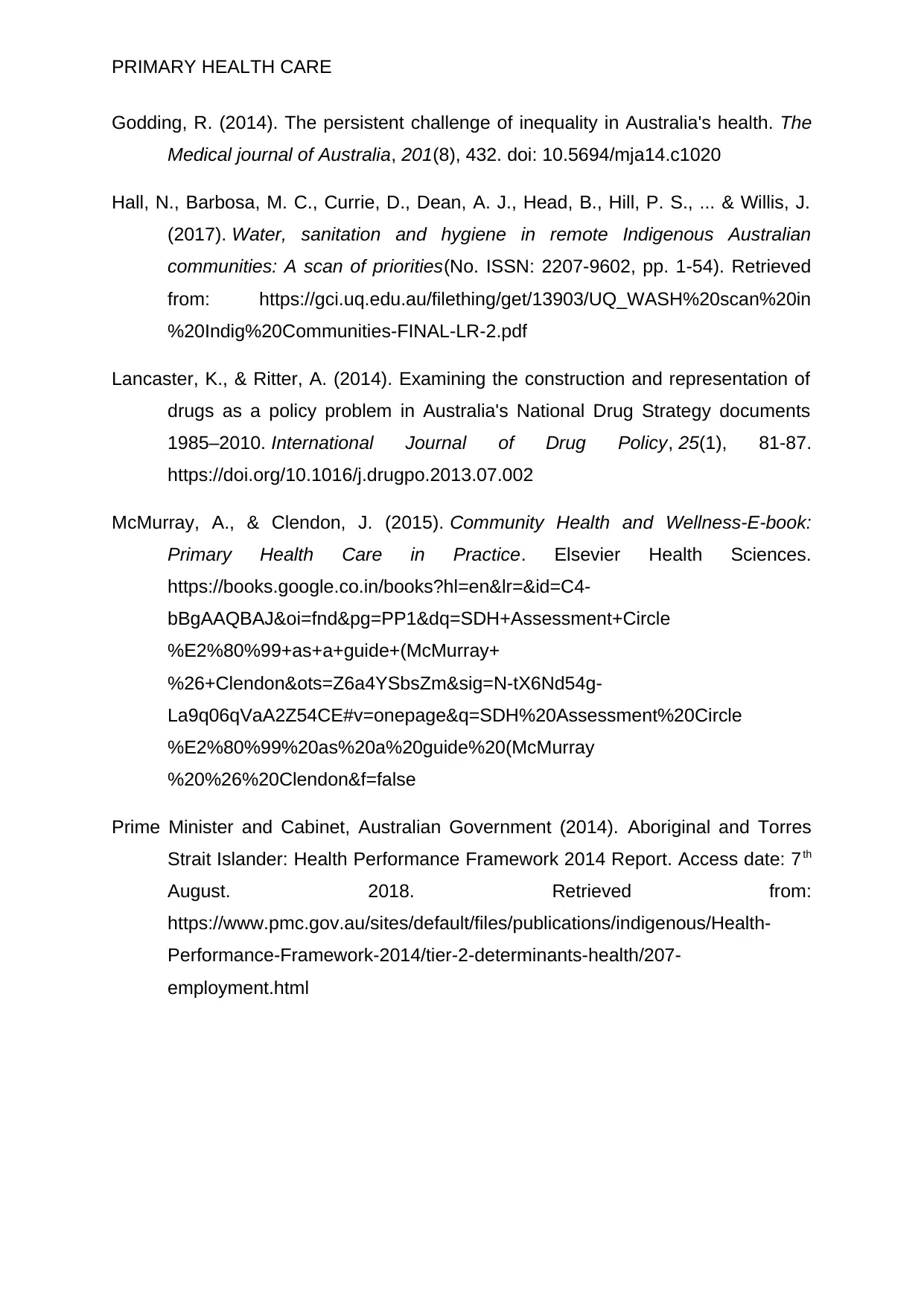
PRIMARY HEALTH CARE
Godding, R. (2014). The persistent challenge of inequality in Australia's health. The
Medical journal of Australia, 201(8), 432. doi: 10.5694/mja14.c1020
Hall, N., Barbosa, M. C., Currie, D., Dean, A. J., Head, B., Hill, P. S., ... & Willis, J.
(2017). Water, sanitation and hygiene in remote Indigenous Australian
communities: A scan of priorities(No. ISSN: 2207-9602, pp. 1-54). Retrieved
from: https://gci.uq.edu.au/filething/get/13903/UQ_WASH%20scan%20in
%20Indig%20Communities-FINAL-LR-2.pdf
Lancaster, K., & Ritter, A. (2014). Examining the construction and representation of
drugs as a policy problem in Australia's National Drug Strategy documents
1985–2010. International Journal of Drug Policy, 25(1), 81-87.
https://doi.org/10.1016/j.drugpo.2013.07.002
McMurray, A., & Clendon, J. (2015). Community Health and Wellness-E-book:
Primary Health Care in Practice. Elsevier Health Sciences.
https://books.google.co.in/books?hl=en&lr=&id=C4-
bBgAAQBAJ&oi=fnd&pg=PP1&dq=SDH+Assessment+Circle
%E2%80%99+as+a+guide+(McMurray+
%26+Clendon&ots=Z6a4YSbsZm&sig=N-tX6Nd54g-
La9q06qVaA2Z54CE#v=onepage&q=SDH%20Assessment%20Circle
%E2%80%99%20as%20a%20guide%20(McMurray
%20%26%20Clendon&f=false
Prime Minister and Cabinet, Australian Government (2014). Aboriginal and Torres
Strait Islander: Health Performance Framework 2014 Report. Access date: 7th
August. 2018. Retrieved from:
https://www.pmc.gov.au/sites/default/files/publications/indigenous/Health-
Performance-Framework-2014/tier-2-determinants-health/207-
employment.html
Godding, R. (2014). The persistent challenge of inequality in Australia's health. The
Medical journal of Australia, 201(8), 432. doi: 10.5694/mja14.c1020
Hall, N., Barbosa, M. C., Currie, D., Dean, A. J., Head, B., Hill, P. S., ... & Willis, J.
(2017). Water, sanitation and hygiene in remote Indigenous Australian
communities: A scan of priorities(No. ISSN: 2207-9602, pp. 1-54). Retrieved
from: https://gci.uq.edu.au/filething/get/13903/UQ_WASH%20scan%20in
%20Indig%20Communities-FINAL-LR-2.pdf
Lancaster, K., & Ritter, A. (2014). Examining the construction and representation of
drugs as a policy problem in Australia's National Drug Strategy documents
1985–2010. International Journal of Drug Policy, 25(1), 81-87.
https://doi.org/10.1016/j.drugpo.2013.07.002
McMurray, A., & Clendon, J. (2015). Community Health and Wellness-E-book:
Primary Health Care in Practice. Elsevier Health Sciences.
https://books.google.co.in/books?hl=en&lr=&id=C4-
bBgAAQBAJ&oi=fnd&pg=PP1&dq=SDH+Assessment+Circle
%E2%80%99+as+a+guide+(McMurray+
%26+Clendon&ots=Z6a4YSbsZm&sig=N-tX6Nd54g-
La9q06qVaA2Z54CE#v=onepage&q=SDH%20Assessment%20Circle
%E2%80%99%20as%20a%20guide%20(McMurray
%20%26%20Clendon&f=false
Prime Minister and Cabinet, Australian Government (2014). Aboriginal and Torres
Strait Islander: Health Performance Framework 2014 Report. Access date: 7th
August. 2018. Retrieved from:
https://www.pmc.gov.au/sites/default/files/publications/indigenous/Health-
Performance-Framework-2014/tier-2-determinants-health/207-
employment.html
⊘ This is a preview!⊘
Do you want full access?
Subscribe today to unlock all pages.

Trusted by 1+ million students worldwide
1 out of 9
Related Documents
Your All-in-One AI-Powered Toolkit for Academic Success.
+13062052269
info@desklib.com
Available 24*7 on WhatsApp / Email
![[object Object]](/_next/static/media/star-bottom.7253800d.svg)
Unlock your academic potential
Copyright © 2020–2025 A2Z Services. All Rights Reserved. Developed and managed by ZUCOL.




